Peugeot 408
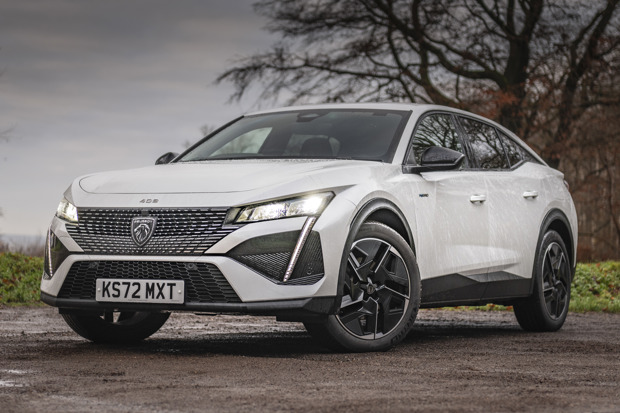
Specifications: Peugeot 408 PHEV
- Run by: Phil Hall since December 2023
- Price when new: £42,375 (£43,765 including options)
- Engine: 1.6-litre plug-in hybrid
- Power: 225PS
- Torque: 360Nm
- Claimed economy: 269.5mpg
- CO2 emissions: 26g/km
- Insurance group: 30
Report 1: Meet our new long-term test Peugeot 408 PHEV
Can Peugeot's left-field hatchback do enough to tempt you away from a generic family SUV? We're living with one for three months to find out...
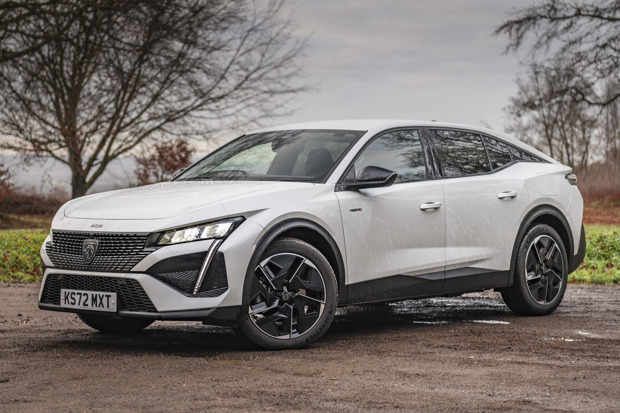
Date: 18 December 2023 | Current mileage: 7021 miles | Claimed economy: 269.5mpg | Actual economy: 57.2mpg
As we way goodbye to one large French family car, we welcome another one. After three months with our Citroen C5 Aircross long-term test car, we've swapped it for a Peugeot 408. And just as the C5 Aircross took a slightly quirky approach to a family SUV, the Peugeot 408 is a bit of a left field choice as well.
You see, you can't really describe it as an SUV. In fact, it's pretty hard to pin down what kind of body type the Peugeot 408 is. Essentially it's a jacked-up hatchback that looks a little like a coupe above the waistline, but at the same time has its fair share of plastic cladding round the wheel arches and rear. A bit like an Audi A4 Allroad or Volvo V60 Cross Country. But it doesn't have four-wheel drive like those two.
Put all of that together and it might sound like a bit of a confused design, but it somehow works. Our Peugeot 408 long-term test car is finished in Pearlescent White (an £850 extra) which probably doesn't do the design justice (we'd plump for either blue or red), but it still has plenty of presence.
Our Peugeot 408 long-term test car comes in Allure Premium trim. This middle of the range trim sits above Allure, but below the snazzier GT trim that's dripping with features. That said, our Allure Premium 408 comes with a good amount of kit as standard, including a 10-inch digital instrument display, reversing camera, front/rear parking sensors, keyless entry/start, electric folding door mirrors, adaptive cruise control and long-range blind spot detection.
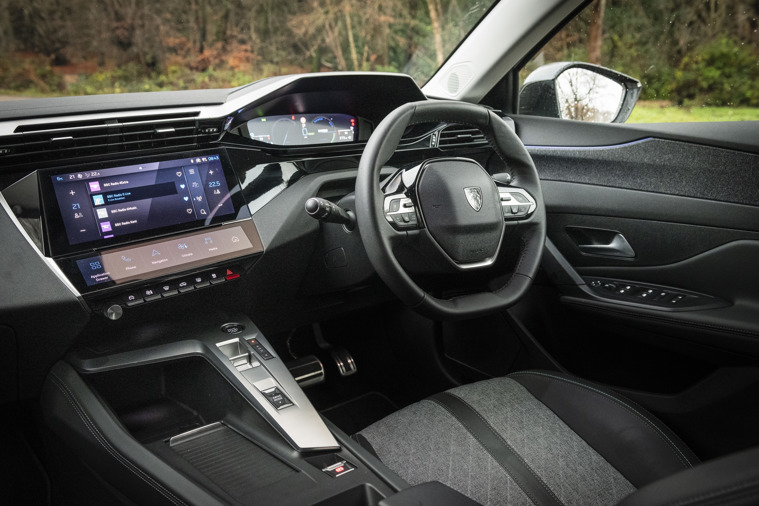
There's also some funky looking 19-inch diamond-cut alloy wheels, a 10-inch touchscreen with both Apple CarPlay and Android Auto as standard (and wireless connection for both). The seats are finished in fabric, which takes some of the chill away on cold mornings as there's no heated seat option on Allure Premium cars (or a heated steering wheel for that matter).
The Peugeot 408 is available with a 1.2-litre 3-cylinder PureTech engine with 130PS, but there's also the choice of two plug-in hybrid engines and we've got the more powerful of the two. The 1.6-litre petrol engine and electric motor combine to deliver 225PS, with 62mph achievable in 7.8 seconds. What's more, it promises up to 40 miles from a fully-charged battery. Our 408 is fitted with an optional 7.4kW Monophase on-board charger (£400 extra) that means we should be able to top the battery up in five and a half hours from a 3-pin plug socket.
Official fuel economy figures are claimed to be between 211.3mpg to 269.5mpg (provided the battery is kept topped up), while the petrol tank is a modest 40 litres - some 12 litres less than a 408 with a 1.2 PureTech petrol engine.
The Peugeot 408 is also pretty big as well. Measuring 4687mm it's not much shorter than a Skoda Superb, while it's longer than SUV rivals like the Cupra Formentor. These dimensions are good news for passenger and boot space, but I'll cover that off in more detail in my next update.
Add this all up and our Peugeot 408 comes in at £43,765 with options, pitting it against a number of plug-in family SUVs and estate cars. We're going to be living with it for the next three months to see how it copes with family life.
Report 2: Getting to grips with our 408
Almost a month in to running our long-term Peugeot 408, how's it going so far?

Date: 2 January 2024 | Current mileage: 7522 miles | Claimed economy: 269.5mpg | Actual economy: 42.7mpg
Our Peugeot 408 long-term test car arrived just before Christmas and the festive break gave me a chance to really spend a good chunk of time with it.
With a three-pin charging lead I was able to keep the battery topped up from the off, but just like the Citroen C5 Aircross PHEV I ran before it, I was disappointed to only find a range of under 20 miles when I jumped in the car after charging all night, and not quite the 40 plus miles claimed. Not the best start, but the optional 7.4kW Monophase on-board charger does mean charging times are pretty brisk.
With a decent trip round the M25 and up the M1 Christmas day, that wasn't going to touch the sides, but it did give me a chance to see what the 408 was like on a long run. Android Auto connected easily (and more importantly for me at least, wirelessly), while once on a moderately quiet M25 the adaptive cruise control was easy to engage and adjust. Unlike some other systems that tend to be a bit overzealous when braking and taking an age to accelerate again, the 408's adaptive cruise control adjusted speed smoothly.
The driving position is good and while you initially feel like you're sitting too high with the Peugeot 408's i-Cockpit, I found I quickly got used to it and it works well, with a clear line of sight to the digital instrument display.

Below the 10-inch touchscreen is another nice feature in the form of i-Toggles. In essence, this is a sub-screen display that provides shortcuts to some of the 408's settings and features. No big deal perhaps, but the fact that you can tailor these to your liking is pretty cool. Especially as you've got a further row of physical metal buttons just below that with controls to things like the heated rear screen and the car's climate control.
This means that the default i-Toggles duplicate existing physical controls, allowing you to have shortcuts to things like BBC 6Music or Google Maps.
After a relatively sedate trip north, the return leg was a bit more of a challenge. Heavy rain on the M1 is never fun and after trying and failing to find a control to trigger the rear windscreen wiper to clear the spray that had been thrown up, the realisation quickly dawned on me that our 408 doesn't have one. A curious omission, but despite this the 408 never felt unsettled on a pretty miserable run home.
There's also bags of space for everyone - the long wheelbase of the 408 means there's ample room in the front and back, with my two girls having plenty of space to stow extra presents they'd acquired that day in the back with them. The boot is great too at 471 litres, though you're losing out about 55 litres to the petrol car without the battery to conceal. It's a useful shape as well and passed my 'can it fit two kid's bikes' test that other family cars struggle to do.
I tried to use the battery charge on the 408 wisely on the trip and only when in low-speed areas, but still only managed just under 43mpg on a long run. Not something that would be massively economical if I was doing that drive regularly, but fine for a one off, and overall the 408 has impressed so far.
Report 3: Plastic trim saves the day
The plastic trim round the wheels isn't just for show...

Date: 19 January 2024 | Current mileage: 7982 miles | Claimed economy: 269.5mpg | Actual economy: 47.8mpg
Winter has come with a bit of a thud in 2024 and we've been greeted by some pretty chilly mornings. In the past I've been able to crank up the heated seats (and in some cases, heated steering wheel) and let the warmth from these cut through the cold.
I'll be the first to recognise that this is very much a first-world problem, but out 408 comes with neither. If you want such luxuries you'll have to opt for the top-of-the-line GT version of the 408, and then select it as an optional extra. Just like the missing rear wiper, it seems like a strange omission on a £40,000+ family car.
Instead, I'm having to force the petrol engine to spring into life to heat the car, as relying solely on the battery to do this means I'll have a long wait to see the temperature creep up and at the same time, see the range shrink as the battery takes the strain.
Something I need to do to avoid this is set-up the 408 with the MyPeugeot app as this will allow me to pre-condition the temperature of the cabin while it's charging - something I'll update you on in a future update.

Heated seat grumble aside, the Peugeot 408 has been slipping nicely into family car duties...until it picked up some damage.
Let's get the excuses out of the way first. It was dark, on a farm and the 408 was trying to be coerced out of a tight space. However, we hadn't factored in a low-lying wood post and as we reversed out, there was a horrible sound of wood on bodywork.
Getting out and expecting to see a big gash along the side of our 408, we were relieved to see that the plastic trim round the wheel arch had taken the brunt of the impact, leaving the bodywork unblemished. I don't know why I'm surprised really, as it did exactly what it was designed to do, with only 3-4 internal clips the real victims of this little incident.
If there was a good time to have a ding like this, then this was it. With the 408 booked in for its first year service in the next few days, replacement clips are on order so this can get sorted at the same time.
Report 4: Should you wait for the Peugeot E-408?
With Peugeot on an EV charge, could the arrival of the E-408 later in the year be the pick of the range?
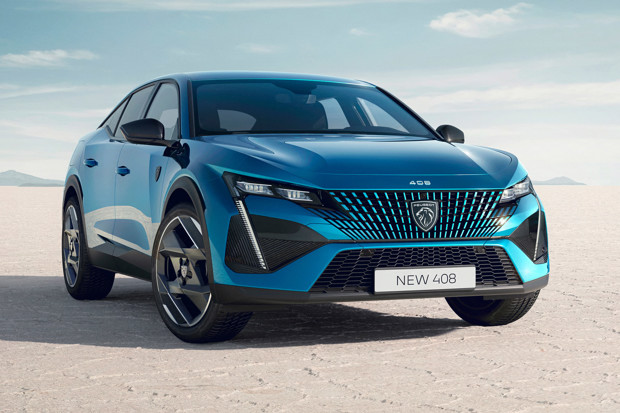
Date: 9 February 2024 | Current mileage: 8358 miles | Claimed economy: 269.5mpg | Actual economy: 48.5mpg
With our 408 away getting it's first service (and some TLC), I had an E-308 for a bit and it got me thinking about the upcoming Peugeot E-408.
Peugeot's been on a bit of an EV charge of late (but which manufacturer hasn't), and with the arrival of the E-408 (along with the upcoming E-5008), it will bring the brand's EV range up 12 models.
Peugeot's almost been too busy, as the arrival of the E-408 was expected to be last year, but it now looks like we'll finally see on in September 2024. But if you're thinking of investing in a 408, should you wait a few months for the EV version to appear?
Details around the E-408 are still a bit thin on the ground, but we're expecting it to use the same underpinnings as the E-308 and E-308 SW.
These cars have an official maximum range of up to 267 miles from a moderately small 54kWh battery that produces 156PS and a 0-62mph time of 9.8 seconds. As the E-408 is likely to be heavier than the E-308, expect range and performance to take a bit of a hit.
But not wanting to judge it before it's even been revealed, I hope the drawnout wait for the E-408 has been so Peugeot can engineer it to accommodate the new (and catchily named) EV STLA Medium platform.
This is the same EV platform that the E-3008 uses, with its 73kWh battery helping this family EV to deliver an official EV range up to 435 miles. Power takes a bit step as well, with the standard car having 210PS and a 320PS dual-motor version on the horizon. It certainly sounds a bit more appealing than the set-up from the E-308.
Factor in the futuristic looks of the 408 and if Peugeot goes down this route, the E-408 could be a cracking family EV. Let's hope so...
Report 5: Our 408's infotainment has a wobble
With our 408's infotainment system locking up when using Android Auto, it gives us a chance to appreciate the built-in sat nav.
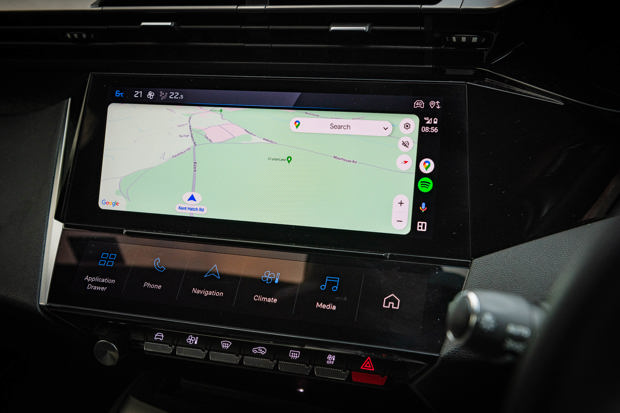
Date: 23 February 2024 | Current mileage: 8876 | Claimed economy: 269.5mpg | Actual economy: 51.2mpg
An early start and a trip round the M25 and up the M40 lied in wait for me last Monday. Jumping in our 408 long-termer and it seamlessly connected to Android Auto, ready for me to key in the address in Google Maps for the journey ahead.
Making sure 6Music was on and the temperature cranked up a little more than usual as it was a cold morning, the only thing left to do was to charge my phone. It's a shame that wireless charging is missing from our 408, especially as it connects wirelessly to Android Auto (and Apple CarPlay), so my phone had to be plugged in via a USB lead to charge.
Once on the move and hitting the M25 and the cabin had warmed up nicely. Pressing the climate control icon on the i-Toggle display to reduce the temperature a touch and nothing happened. Odd, so I gave the dedicated climate control switch a jab instead, but again, nothing. It was the same story trying to change the radio station as well - nothing. Pressing the home button at least did something, but it also meant I couldn't see Google Maps any longer and the icon had dropped out of the display. Weirdly though I was still getting turn-by-turn directions from it in the centre of the digital instrument display.
Whatever I did, there was no getting back to the Google Map display. Could I live with it for the rest of the trip? I still had some kind of navigation, but it was getting stuffy in the cabin with the climate control blasting out heat, while the risk of finishing my journey with Mary Ann Hobbs on the airwaves was too much.
Would I need to stop and restart? Before resorting to that I unplugged my phone and it seemed to sort out most of my problems, though it wouldn't reconnect to Android Auto. With no Google Maps I resorted to the 408's built-in sat nav - something I hadn't bothered to use until now, but I was pleasantly surprised. Powered my TomTom, it worked really well. It gave me a nice linear breakdown of what was coming up on my journey, and perhaps most importantly, it was nice and easy to use.
These little gremlins are frustrating, but it also made me appreciate the 408's navigation interface and be a little less snobby about using Android Auto.
Report 6: Goodbye to our Peugeot 408
We wave goodbye to our Peugeot 408 after three months and some 2500 miles later.
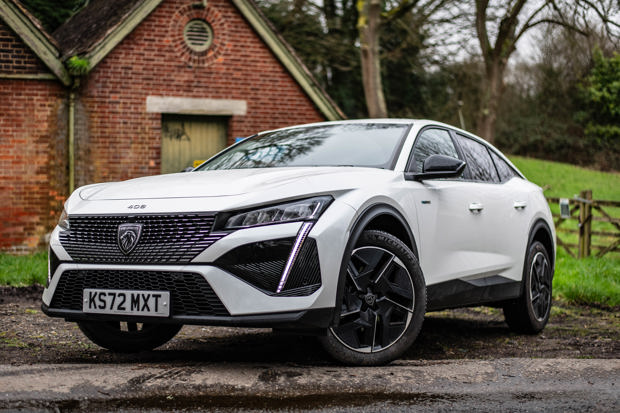
Date: 15 March 2024 | Current mileage: 9456 | Claimed economy: 269.5mpg | Actual economy: 52.1mpg
Our three months with the Peugeot 408 have come to an end while it hasn't won me over completely, there's a lot to like about it and for some it'll make a great family car.
So what hasn't impressed me? Like the Citroen C5 Aircross long-termer I ran before it, I've been really disappointed with the actual range I'm getting from the plug-in hybrid system. On a full charge I'm lucky to get a range of 18 miles. While I accept that the 40-odd-mile range quoted officially might be a stretch, less than 50% in real world use is disappointing. And this wasn't even in really cold conditions either.
This meant that it was fine for short trips into town and doing the school run, but I was having to plug it in pretty much each night, rather than once every other night that I've been able to do with other PHEVs. For the significant price difference over the 1.2-litre PureTech it makes it a hard one to justify unless you're having it as a company car and can save money through BIK.
I know our 408 wasn't in the snazzier GT trim, but I was still disappointed to not find creature comforts like heated seats, a heated steering wheel and wireless charging on a car that's looking to be considered a bit more upmarket than rivals. That said, there's not really any complaints about the interior quality in the 408, with plenty of soft-touch materials, though the leather steering wheel from the GT spec car would be a welcome upgrading over the fairly hard material used in our Allure spec car.
Otherwise the 408 has been a great family car. There's ample space for a family of four, while the boot, even with the PHEV's reduced capacity, is more than spacious enough for most people's needs.
It's an excellent long-distance cruiser, gliding along at motorway speeds with ease. This was underlined in the last month or so where I had numerous long distance trips, and ignoring the wobble we had with Android Auto on one journey, it performed admirably. The seats and driving position are really good, while the compact steering wheel and i-Cockpit worked well for me, though appreciate not everyone will get on with this set-up.
Finally, I like the fact that it's hard to pigeonhole. Bringing elements of an SUV, a hatchback and coupe into a single car design looks confused on paper, but the mish-mash works and its bold styling certainly has presence. Three months on and I still don't think the white paint does the 408 justice - red or blue is definitely the way to go if you're spec'ing your own one.
Speaking of which, if I was configuring my own 408 I think I'd save a big chunk of cash and avoid in the PHEV in favour of the punchy little 1.2-litre PureTech instead, and with the money saved go all in on the 408 in GT trim.
The 408 has been a great family car that has bags of space, but I think spec'ing it this way would overcome some of my bigger frustrations I've had and make it a more tempting proposition.
